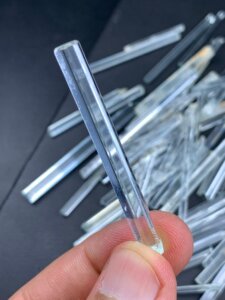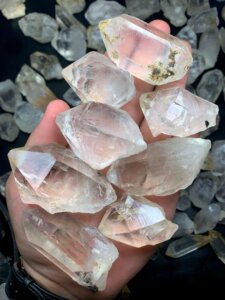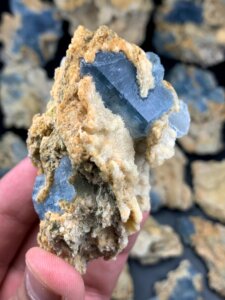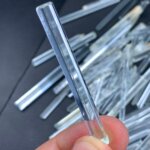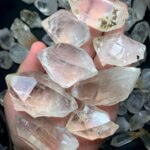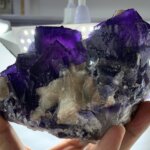Fluorite is often called the “most colorful mineral in the world” — and for good reason. The multi-colored Fluorite crystal formation captures a spectrum of beauty that few minerals can rival. From soft lilac and deep purple to vibrant green, blue, yellow, and even colorless zones, each specimen tells a story of Earth’s artistic chemistry and geological evolution.
In this guide, we’ll explore everything collectors and gemstone buyers should know about multi-colored Fluorite — from its geological formation to buying tips, care advice, and its growing popularity in the U.S. collector market.
What Is Multi-Colored Fluorite Crystal Formation?
Fluorite (calcium fluoride, CaF₂) is a halide mineral known for its remarkable cubic and octahedral crystal forms.
A multi-colored Fluorite formation occurs when different trace elements, radiation exposure, or impurities create zones of varying colors within the same crystal structure.
Each color band represents a change in the geological environment — making every piece truly one-of-a-kind.
Common colors in multi-colored Fluorite include:
- Purple: caused by yttrium or radiation.
- Green: linked to rare earth elements or hydrocarbons.
- Blue: from trace yttrium or color centers.
- Yellow: from organic matter or iron.
- Pink or Red: due to rare impurities and crystal defects.
The result? A breathtaking natural mosaic — a crystal that displays multiple hues when viewed under light or from different angles.
The Geological Formation of Fluorite
Fluorite forms in hydrothermal veins, limestone cavities, and pegmatites, often associated with minerals like quartz, calcite, barite, and galena.
How Multi-Colored Fluorite Forms:
- Hydrothermal Activity: Hot, mineral-rich water flows through cracks in rocks.
- Deposition: Calcium and fluoride ions combine to create CaF₂ crystals.
- Color Zoning: Variations in temperature, pressure, and trace elements cause bands of different colors to develop over time.
- Crystal Growth: Slow cooling allows sharp cubic or octahedral crystals to form — often with distinct color zones inside.
Famous localities known for multi-colored Fluorite formations include:
- Cave-in-Rock, Illinois (USA): Renowned for banded purple and yellow Fluorite cubes.
- Durham, England: Home to classic blue and violet specimens.
- Balochistan, Pakistan: Produces stunning green, blue, and purple combinations.
- China (Hunan, Guangxi): A leading source for gem-grade, rainbow Fluorite clusters.
Visual Beauty: Why Collectors Love Multi-Colored Fluorite
Collectors and decorators alike are drawn to Fluorite’s:
- Vivid natural color zoning — no dyes, no enhancements.
- Geometric perfection — sharp cubic or interlocking crystal habits.
- Transparency and glow — many pieces exhibit strong fluorescence under UV light.
- Symbolic appeal — Fluorite is often called the “Genius Stone,” believed to boost clarity and intuition.
When displayed under natural light or LED illumination, the internal layering of multi-colored Fluorite creates a mesmerizing 3D effect — as if color itself were crystallized.
Fluorite’s Physical and Optical Properties
| Property | Details |
|---|---|
| Chemical Formula | CaF₂ (Calcium Fluoride) |
| Hardness (Mohs) | 4 |
| Luster | Vitreous (Glass-like) |
| Crystal System | Isometric (Cubic) |
| Cleavage | Perfect in four directions |
| Transparency | Transparent to translucent |
| Fluorescence | Often blue or violet under UV light |
Because of its perfect cleavage and relatively soft nature, Fluorite requires gentle handling — especially for display or jewelry use.
The Historical and Metaphysical Significance of Fluorite
Historical Uses
- Ancient Romans carved Fluorite into drinking vessels, believing it prevented drunkenness.
- In the 19th century, Fluorite was used industrially for smelting and as a source of fluoride.
- Collectors throughout Europe prized multi-colored specimens for cabinets of curiosities.
Metaphysical Beliefs
While not scientifically proven, Fluorite is widely appreciated in the metaphysical community:
- Purple Fluorite: Spiritual awareness and meditation.
- Green Fluorite: Cleansing and renewal.
- Blue Fluorite: Calming communication.
- Yellow Fluorite: Creativity and focus.
A multi-colored Fluorite formation is believed to combine these energies — symbolizing balance, harmony, and clarity.
How to Identify Authentic Multi-Colored Fluorite
With its popularity in the collector’s market, imitation or treated Fluorite occasionally appears online.
Here’s how to verify authenticity:
1. Natural Zoning: Look for irregular, organic color transitions — not uniform or painted-looking bands.
2. Hardness Test: Fluorite scratches easily (Mohs 4) — harder minerals like quartz cannot.
3. UV Test: Genuine Fluorite often fluoresces blue or violet under ultraviolet light.
4. Temperature Feel: Real Fluorite feels cool to the touch.
5. Trusted Source: Always buy from verified dealers or mineral galleries.
Caring for Multi-Colored Fluorite Specimens
Because of its softness and perfect cleavage, Fluorite requires careful handling and storage:
Do:
- Store in a padded display case.
- Keep out of direct sunlight (colors can fade with prolonged exposure).
- Clean gently with lukewarm water and a soft cloth.
- Use LED lighting for safe, vivid display.
Don’t:
- Expose to heat or chemical cleaners.
- Place near harder minerals that may cause scratches.
Buying Guide: Multi-Colored Fluorite for Collectors and Buyers
When purchasing a multi-colored Fluorite crystal formation, consider the following factors:
1. Color and Zoning
Seek specimens with clear, vibrant transitions between colors — especially purple-green-blue combinations, which are most sought after.
2. Transparency and Luster
Transparent crystals with a glassy luster are ideal for collectors and display.
3. Size and Form
- Cabinet specimens (7–10 cm) are popular among advanced collectors.
- Miniatures make affordable, entry-level options.
- Massive clusters are ideal for decor or display lighting.
4. Origin
Collectors often prefer Fluorite from famous localities such as:
- Balochistan, Pakistan
- Hunan, China
- Illinois, USA
- Derbyshire, UK
5. Condition
Inspect for chips, cracks, or repairs. Natural edges are fine, but damage reduces value.
6. Price Range
Depending on size and quality:
- Small polished pieces: $10–30
- Cabinet specimens: $100–400
- Rare locality or flawless clusters: $500+
Tips for Buying Fluorite Online
- Buy from reputable stores (look for clear origin info and high-res photos).
- Check lighting photos — natural daylight images reveal true color zoning.
- Avoid overly saturated colors — they may be artificially enhanced.
- Read return policies — trusted sellers offer satisfaction guarantees.
- Ask questions — professional sellers will share mineralogical details freely.
Fluorite in Jewelry and Decor
Though not as hard as quartz or sapphire, Fluorite’s aesthetic appeal makes it a favorite for:
- Pendant stones and cabochons (used occasionally in fine jewelry).
- Display clusters in home décor.
- Office or meditation spaces for color and energy balance.
Collectors love how each multi-colored Fluorite crystal formation adds personality and depth to any mineral collection — a perfect fusion of science and art.
Fluorescence: The “Glow” in Fluorite
Under UV light, many Fluorite crystals emit a brilliant blue or violet glow — a phenomenon that gave the term “fluorescence” its name.
Collectors often display their Fluorite under dual lighting — white for natural color, UV for that magical radiance.
FAQs About Multi-Colored Fluorite Crystal Formations
1. Is multi-colored Fluorite natural or dyed?
Authentic multi-colored Fluorite is naturally colored through trace elements and radiation exposure. However, some low-quality stones on the market may be dyed — always verify with a trusted source.
2. Can Fluorite be used in jewelry?
Yes, but only for pendants or earrings where it’s less likely to be scratched. It’s too soft for rings or daily-wear pieces.
3. How do I display my Fluorite specimen?
Use soft LED light in a glass cabinet or acrylic case. Avoid direct sunlight to preserve color intensity.
4. What is the rarest Fluorite color combination?
Blue and green with purple zoning is among the rarest and most desirable combinations.
5. Where can I buy high-quality multi-colored Fluorite specimens?
Reputable online mineral galleries and specialty sellers like Luminex Specimen, The Arkenstone, and Mineral Masterpiece offer verified specimens with detailed locality info.
Conclusion: A Collector’s Treasure of Color and Light
A multi-colored Fluorite crystal formation is more than just a mineral — it’s a geological painting forged in Earth’s heart.
Each specimen reveals billions of years of nature’s artistry through mesmerizing hues, geometric perfection, and pure natural beauty.
Whether you’re a collector, decorator, or gemstone buyer, owning a piece of Fluorite connects you directly to the planet’s creative forces.
Explore the beauty of Fluorite in our exclusive collection — and bring home a timeless symbol of clarity, balance, and brilliance.

